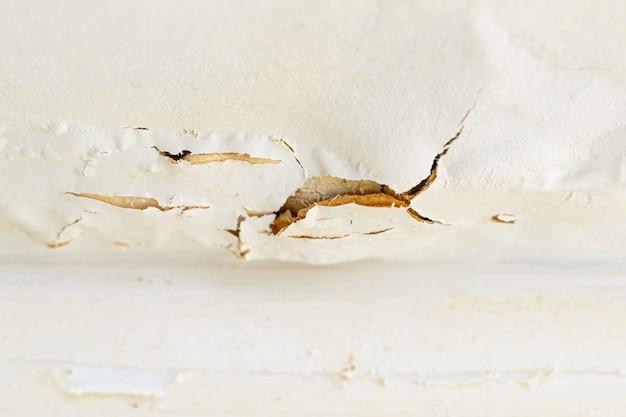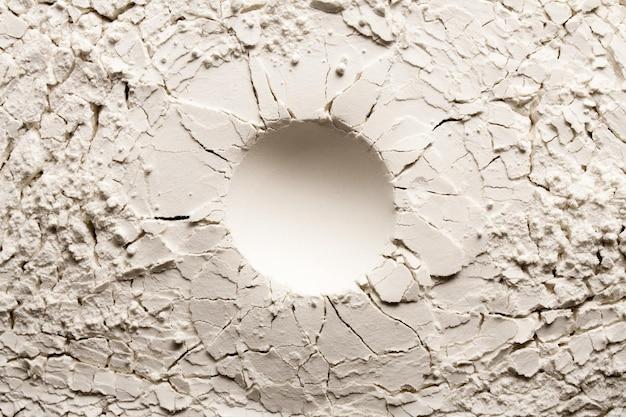Whether you’re an artist or a DIY enthusiast, you’ve probably used plaster of Paris at some point. It’s a versatile material used in various applications, from creating artwork and molds to repairing walls and making castings. However, one common issue that many people encounter with plaster of Paris is cracking.
In this blog post, we will unravel the mystery behind why plaster of Paris cracks and explore the factors that contribute to this problem. We’ll also uncover tips and techniques to prevent cracking and ensure your plaster projects stand the test of time. So, if you’ve ever wondered why your plaster of Paris creations develop unsightly cracks or if there are alternative materials to consider, this post is for you. Let’s dive in and understand the science behind this fascinating phenomenon!
Why Does Plaster of Paris Crack
Plaster of Paris, the trusty material that has been used for centuries in art, construction, and DIY projects. It’s versatile, easy to work with, and sets quickly. But why oh why does this reliable plaster sometimes crack, leaving us scratching our heads in frustration? Fear not, dear reader, for we are here to delve into this plaster predicament and provide you with all the answers you seek!
A Delicate Dance between Water and Powder
You see, the cracking of plaster of Paris is not a simple mystery, but rather a delicate dance between water and powder. When you mix these two components together, they chemically react to form a solid mass. But here’s the catch – plaster of Paris has a mind of its own. It sets by a process called hydration, where the water molecules combine with the powder particles to form crystals.
The Witchcraft of Drying Time
Now, brace yourselves, because we’re about to dive headfirst into the dark arts of drying time. When you apply plaster of Paris to a surface, it starts to harden almost instantly. Within minutes, it transforms from a gooey mixture into a solid structure. But hold your horses, my friend, because the process isn’t over just yet. Plaster of Paris continues to dry for hours, sometimes even days, as the water molecules gradually evaporate.
The Notorious Enemy: Rapid Drying
Ah, the infamous culprit behind many a cracked plaster masterpiece – rapid drying. Picture this: you’ve meticulously applied your plaster of Paris, smoothing it out with care and precision. But alas, impatience strikes, and you crank up the heater or blast it with a hairdryer, hoping to speed up the drying process. Well, guess what, my enthusiastic friend? Rapid drying is the perfect recipe for disaster.
The Battle of Uneven Drying Rates
When you rush the drying process, the outer layer of the plaster dries quicker than the inner layers. This creates a battle of uneven drying rates, as the outer layer shrinks and cracks while the inner layers try to keep up. The result? A cacophony of fissures and fractures, leaving you with a less-than-perfect finish. So, take a deep breath, practice patience, and let nature do its magical work.
Avoid Extremes: Temperature and Humidity
If uneven drying rates are the arch-enemy of plaster of Paris, then extreme temperature and humidity are their trusty sidekicks. Just like Goldilocks seeking the perfect porridge, plaster of Paris needs to dry under ideal conditions. Avoid exposing your freshly plastered project to extreme heat, cold, or humidity. Optimal room temperature and a moderate humidity level will help your plaster set smoothly.
A Twist in the Tale: Mixing and Ratios
But of course, the adventure of plaster of Paris cracking wouldn’t be complete without a twist in the tale – mixing and ratios. Achieving the right consistency is key when mixing plaster of Paris. If your mix is too thin, it can weaken the structure, making it more prone to cracking. On the other hand, if the mix is too thick, it may not properly bind, leading to the same undesirable outcome.
The Elusive Secret: Proper Preparation and Application
Now that we’ve covered the major players in the plaster of Paris cracking saga, let’s not forget the elusive secret to success – proper preparation and application. Ensure your surface is clean and free from dust and debris. Apply a suitable primer or sealer before plastering to promote adhesion. And when it comes to application, use even strokes, working methodically, and avoid overworking the plaster.
In this epic journey through the cracks and crevices of plaster of Paris, we’ve discovered that rapid drying, uneven drying rates, extremes in temperature and humidity, mixing ratios, and improper application all play a role in the cracking phenomenon. Armed with this newfound knowledge, we implore you to approach your next plastering project with confidence and patience. Remember, dear reader, every crack is a lesson learned and an opportunity for improvement. So, go forth, embrace the magic of plaster of Paris, and let your creativity shine, crack-free!
FAQ: Why Does Plaster of Paris Crack
What is plaster of Paris used for
Plaster of Paris is a versatile material commonly used for arts and crafts projects, sculptures, and creating molds. It’s also used in construction for creating decorative elements, repairing walls, and making smooth finishes.
Is plaster of Paris harmful to health
Plaster of Paris is generally safe to use, but caution should be exercised during mixing and application. Avoid inhaling the fine particles to prevent respiratory irritation. It’s advisable to wear gloves and long sleeves to protect your skin from potential contact dermatitis.
What is the hardest type of plaster
While plaster of Paris is widely used, it is not the hardest type of plaster available. Gypsum plaster, also known as “plaster of Paris plus,” is a slightly modified version that offers greater hardness and durability.
What is stronger than plaster of Paris
For applications that require increased strength, a gypsum-based plaster such as lime plaster or cement plaster would be a better choice. These plasters have a higher resilience and can withstand greater pressure and impact.
Will plaster of Paris last outside
Plaster of Paris is not suitable for outdoor use as it is not waterproof and can deteriorate when exposed to moisture and harsh weather conditions. It is best to use other materials specifically designed for outdoor applications.
What is an alternative to plaster of Paris
If you are in need of a plaster substitute, there are various options available. Some popular alternatives include epoxy putty, air-dry clay, polymer clay, or even papier-mâché. These alternatives offer different properties and can be chosen based on your specific project needs.
Why is my plaster cracking
There can be several reasons why plaster of Paris may crack. The most common causes include insufficient drying time, inadequate reinforcement, improper mixing ratios, excessive heat or cold, and inadequate surface preparation. Identifying the underlying cause will help you prevent future cracks.
Is plaster of Paris waterproof
No, plaster of Paris is not waterproof. It is a porous material that can absorb moisture. When exposed to water or high humidity, it can soften, crumble, and eventually lose its structural integrity. It is essential to keep plaster of Paris dry or use waterproofing sealants if needed.
Does plaster of Paris break easily
Plaster of Paris is relatively fragile and can break easily when subjected to pressure or impact. While it can provide a smooth and aesthetically pleasing finish, it lacks the strength and durability of other materials like concrete or gypsum plasters.
Is it normal for plaster to crack
In certain situations, minor hairline cracks in plaster can be considered normal and can occur due to natural settlement or changes in temperature and humidity. However, significant or recurring cracks may indicate underlying structural issues or improper installation.
What causes plaster of Paris to crack
The primary causes of plaster of Paris cracking include rapid drying, insufficient support, improper expansion joints, poor mixing technique, temperature fluctuations, or exposure to moisture. Understanding these factors will allow you to minimize the risk of cracking and achieve better results.
How do you stop plaster from cracking
To prevent plaster from cracking, ensure proper surface preparation, add reinforcement like mesh or fibers, maintain consistent drying conditions, avoid rapid drying methods, use expansion joints in larger areas, and follow the manufacturer’s instructions for proper mixing ratios.
Does plaster of Paris shrink when it dries
Yes, plaster of Paris undergoes some shrinkage as it dries. The drying process involves the evaporation of water from the material, which can cause slight contraction. Understanding this shrinkage is important when planning and executing projects to avoid potential issues.
How do you keep plaster of Paris from cracking
To minimize the chances of plaster of Paris cracking, sprinkle the powder evenly into the water while stirring gently, avoid over-mixing, use warm water for better workability, apply multiple thin coats instead of one thick layer, and ensure proper curing and drying time.
What does plaster of Paris not stick to
Plaster of Paris does not adhere well to non-porous surfaces such as glass, metal, or plastic. To improve adhesion on such surfaces, it is recommended to use a primer or apply a bonding agent before applying the plaster.
What are the disadvantages of plaster of Paris
Despite its versatility, plaster of Paris has a few drawbacks. It is not waterproof, prone to cracking, relatively fragile, requires proper ventilation when working with it, and needs careful handling due to its potential for skin irritation. It’s important to consider these factors when choosing a material for your project.
Should I be worried about hairline cracks in plaster
Hairline cracks in plaster are often considered normal and may occur due to normal settling of a building or minor temperature fluctuations. However, if the cracks are widening or recurring, it may indicate larger structural issues that require professional evaluation.
Does plaster of Paris dry hard
Yes, plaster of Paris dries to form a hard and solid finish. Once fully cured, it can be sanded, painted, or decorated as desired. However, it’s important to note that plaster of Paris is not as hard or durable as materials like cement or concrete.
How fragile is plaster of Paris
Plaster of Paris is relatively fragile and can be easily damaged if not handled with care. It can chip, crack, or break when subjected to pressure, impact, or excessive force. Take precautions to protect your finished plaster work to ensure its longevity.
Can I use plaster of Paris to repair drywall
Plaster of Paris can be used as a temporary fix for minor cracks in drywall or plaster walls. However, it is not recommended for large repairs or structural issues. For significant repairs, it is best to consult a professional or use appropriate drywall patching materials for a more durable and long-term solution.

